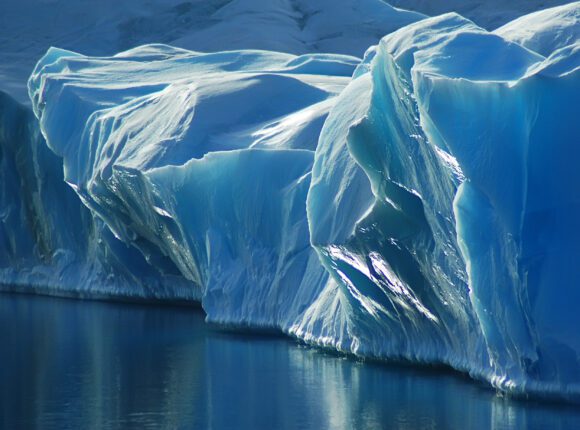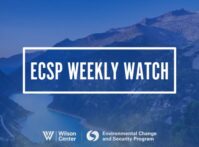-
Facing Up to Climate Risk: Arctic Sea Ice, Tipping Points, and Possible Interventions

Global greenhouse gas emissions continue in stark contrast to the emissions reductions needed to limit warming to 1.5 degrees Celsius. Indeed, planetary warming has accelerated so much that many scientists warn that key components of the earth’s system are approaching “tipping points” that will trigger additional climate feedback loops that further fuel and exacerbate climate disruption if they are exceeded.
Given the enormity of these well-understood risks, society needs an accelerated and more robust strategy to slow and ultimately reverse climate disruption. Rapid and deep global decarbonization is essential, as is work to remove large amounts of legacy carbon pollution from the atmosphere and ocean. Yet the changes we are observing underscore the need for an additional element: restoring and repairing critical ecosystems to prolong the vital climate stabilization functions they provide and to avert climate tipping points.
Arctic sea ice is one such ecosystem in need of restoration and repair. It is a critical foundation of the global climate system—affecting global weather patterns and ocean circulation.
The transformation taking place at the top of the globe from ice to ocean—from white to blue—has resulted in significant loss of planetary reflectivity, with a corresponding increase in the absorption of excess heat into the Arctic ocean. This is why the Arctic region has warmed three to four times faster than the global average, a phenomenon known as “Arctic amplification.” And while not considered a tipping point in itself, the loss of summer Arctic sea ice is accelerating the approach of other cryosphere tipping points, such as northern permafrost and the Greenland ice sheet.
Our work at Ocean Visions—a science-based conservation organization at the center of a network of institutions dedicated to the conservation and restoration of our ocean—seeks to advance a combined agenda of decarbonization, removal of legacy pollution, and ecosystem restoration and repair. Arctic sea ice has become a specific focus of our organization’s efforts.
Recovery of Arctic Sea Ice
Summer sea ice is expected to disappear as early as 2035, given current rates of decline. Given the near-term risks associated with this continued loss, scientists, and engineers have started to research pathways to try to slow down this process. Global strategies such as reflecting sunlight back into space might help cool the region, while locally targeted approaches (thickening sea ice) may slow the rate and extent of melting. Yet these and all other potential approaches demand significant and accelerated research before we know if they are effective and safe.
Over the last year, Ocean Visions conducted a deep assessment of all currently known approaches to prolong the life of Arctic sea ice. They fall into five major groupings: spatial protections, pollution management, ice management, surface albedo modification and solar radiation modification.
Using a multidisciplinary lens, we assessed 21 approaches based on criteria including their current technology readiness, potential impact on temperature and sea ice extent, their reversibility, the potential environmental and social co-benefits and risks, as well as a range of governance considerations. Our assessment identified key knowledge gaps and identified the highest priorities for further research and actions to advance engagement and governance. We published these details as a digital, interactive road map.
The bottom line was clear. Our study identified 15 of the 21 approaches as potentially viable. These potential solutions could move from the lab to demonstration projects, or beyond, over the next five to ten years—which is our likely window for action to save summer sea ice.
Some of the approaches we examined, such as technologies to rapidly reduce methane emissions, are already mature and can and should be scaled immediately. Others, such as ice thickening or cloud thinning, are still in early stages that make them prime targets for accelerated research and development.
Ensuring Ethical Research and Governance
Solving thorny outstanding technology questions is only part of the equation. Important social, cultural, political, and ethical issues associated with research into methods of prolonging Arctic sea ice also must be addressed simultaneously.
Our assessment identified substantial knowledge gaps concerning governance and justice. Arctic sea ice sustains ecosystems and communities whose security is also dependent on the ice. Any efforts to prolong Arctic sea ice must be informed by Arctic Indigenous peoples and Arctic communities—and explored in partnership with them.
There are many areas of potential concern raised by this work. Most obvious is the possibility for unintended environmental consequences and inequitable impacts on vulnerable populations. Yet questions about how to define and engage “affected communities” also loom large—given the Arctic’s telekinetic linkages to weather around the globe.
Effective governance is essential to address concerns and ensure that decisions are made responsibly and equitably, for both current and future generations. Far greater human and financial resources also must be deployed to advance our collective knowledge of the most promising concepts.
Ocean Visions has created the Arctic Sea Ice Restoration Research Fund (Fund) to move forward with responsible exploration of the most promising approaches. The Fund will provide critical financial support necessary for the research needed to increase societal knowledge of these potential options. Our effort also will operate with high transparency and robust governance, and it will support only scientifically rigorous research that is conducted transparently, with information sharing and a clear line of sight to related issues, such as governance, equity, risks, and justice.
Restoring major parts of the earth’s system is mind-bogglingly complex, and it is a task filled with substantial ethical dilemmas. But the risks of taking no action are immense. It is time for the global community to have informed, deliberate, and transparent discussions about if, and how, climate interventions may play a role in avoiding tipping points while we reduce and remove carbon pollution. We intend to play a role in sparking and deepening those discussions.
Brad Ack is Chief Executive Officer at Ocean Visions.
Kerry J. Nickols is a Senior Program Officer at Ocean Visions.
Sources: BioScience; National Snow and Ice Data Center; Ocean Visions; UNEP
Photo credit: A small part of the sun-reflecting blue front of a larger iceberg. The calm water reflects the beautiful blue ice. Picture was taken during a 3-month Antarctic research expedition near the Peninsula, courtesy of Armin Rose/shutterstock.com.
 A Publication of the Stimson Center.
A Publication of the Stimson Center.







